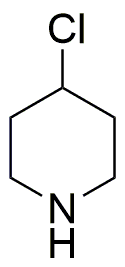4-Chloropiperidine is widely utilized in research focused on:
- Synthesis of Pharmaceuticals: This compound serves as a key intermediate in the synthesis of various pharmaceutical agents, particularly in the development of medications targeting neurological disorders.
- Agrochemical Development: It is employed in the formulation of agrochemicals, enhancing the efficacy of pesticides and herbicides by improving their chemical stability and biological activity.
- Material Science: 4-Chloropiperidine is used in the production of specialty polymers and resins, contributing to materials with enhanced durability and chemical resistance.
- Research in Organic Chemistry: This compound acts as a versatile building block in organic synthesis, allowing researchers to explore new chemical reactions and develop novel compounds.
- Biochemical Studies: It is utilized in the study of enzyme inhibitors and receptor interactions, providing insights into biological processes and potential therapeutic targets.
General Information
Properties
Safety and Regulations
Applications
4-Chloropiperidine is widely utilized in research focused on:
- Synthesis of Pharmaceuticals: This compound serves as a key intermediate in the synthesis of various pharmaceutical agents, particularly in the development of medications targeting neurological disorders.
- Agrochemical Development: It is employed in the formulation of agrochemicals, enhancing the efficacy of pesticides and herbicides by improving their chemical stability and biological activity.
- Material Science: 4-Chloropiperidine is used in the production of specialty polymers and resins, contributing to materials with enhanced durability and chemical resistance.
- Research in Organic Chemistry: This compound acts as a versatile building block in organic synthesis, allowing researchers to explore new chemical reactions and develop novel compounds.
- Biochemical Studies: It is utilized in the study of enzyme inhibitors and receptor interactions, providing insights into biological processes and potential therapeutic targets.
Documents
Safety Data Sheets (SDS)
The SDS provides comprehensive safety information on handling, storage, and disposal of the product.
Product Specification (PS)
The PS provides a comprehensive breakdown of the product’s properties, including chemical composition, physical state, purity, and storage requirements. It also details acceptable quality ranges and the product's intended applications.
Certificates of Analysis (COA)
Search for Certificates of Analysis (COA) by entering the products Lot Number. Lot and Batch Numbers can be found on a product’s label following the words ‘Lot’ or ‘Batch’.
*Catalog Number
*Lot Number
Certificates Of Origin (COO)
This COO confirms the country where the product was manufactured, and also details the materials and components used in it and whether it is derived from natural, synthetic, or other specific sources. This certificate may be required for customs, trade, and regulatory compliance.
*Catalog Number
*Lot Number
Safety Data Sheets (SDS)
The SDS provides comprehensive safety information on handling, storage, and disposal of the product.
DownloadProduct Specification (PS)
The PS provides a comprehensive breakdown of the product’s properties, including chemical composition, physical state, purity, and storage requirements. It also details acceptable quality ranges and the product's intended applications.
DownloadCertificates of Analysis (COA)
Search for Certificates of Analysis (COA) by entering the products Lot Number. Lot and Batch Numbers can be found on a product’s label following the words ‘Lot’ or ‘Batch’.
*Catalog Number
*Lot Number
Certificates Of Origin (COO)
This COO confirms the country where the product was manufactured, and also details the materials and components used in it and whether it is derived from natural, synthetic, or other specific sources. This certificate may be required for customs, trade, and regulatory compliance.


